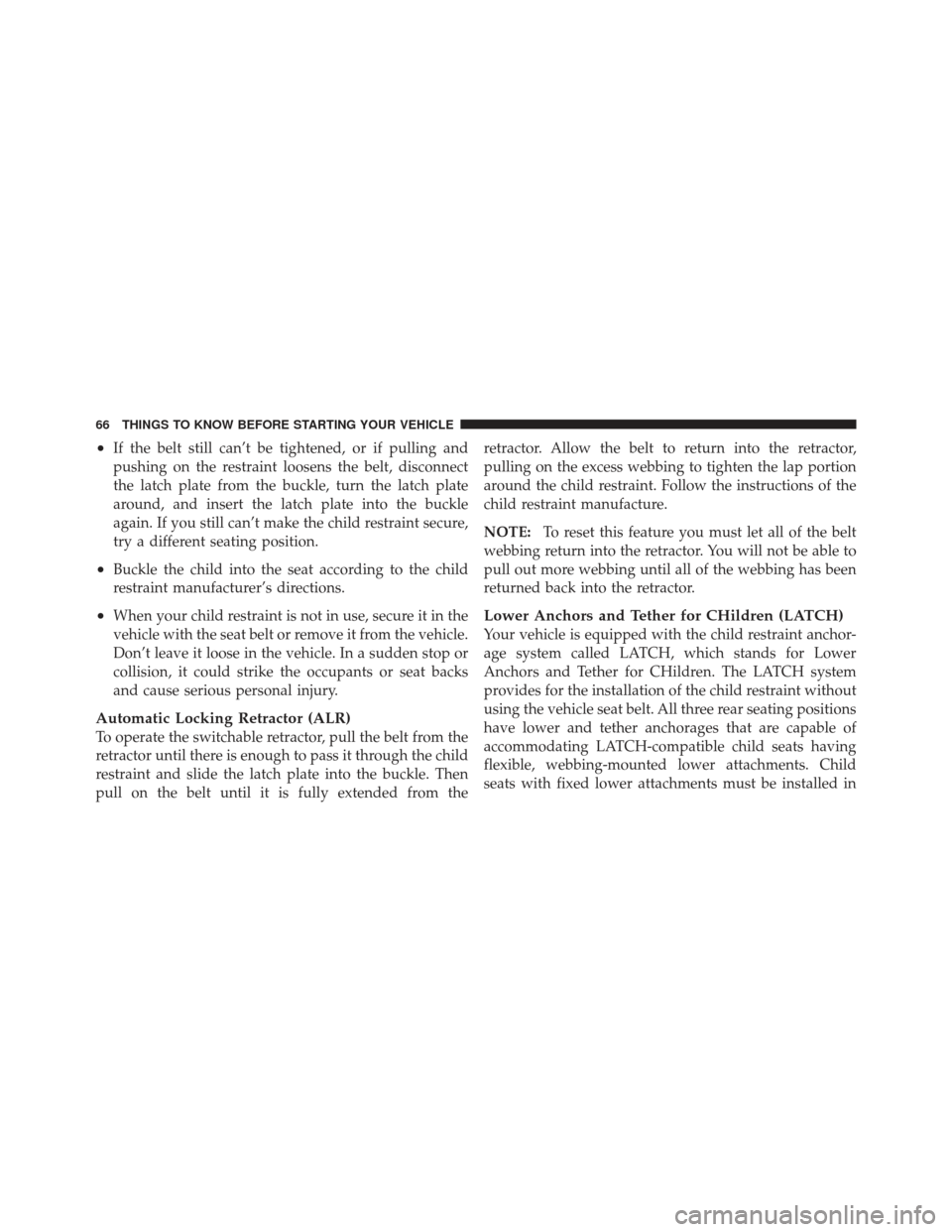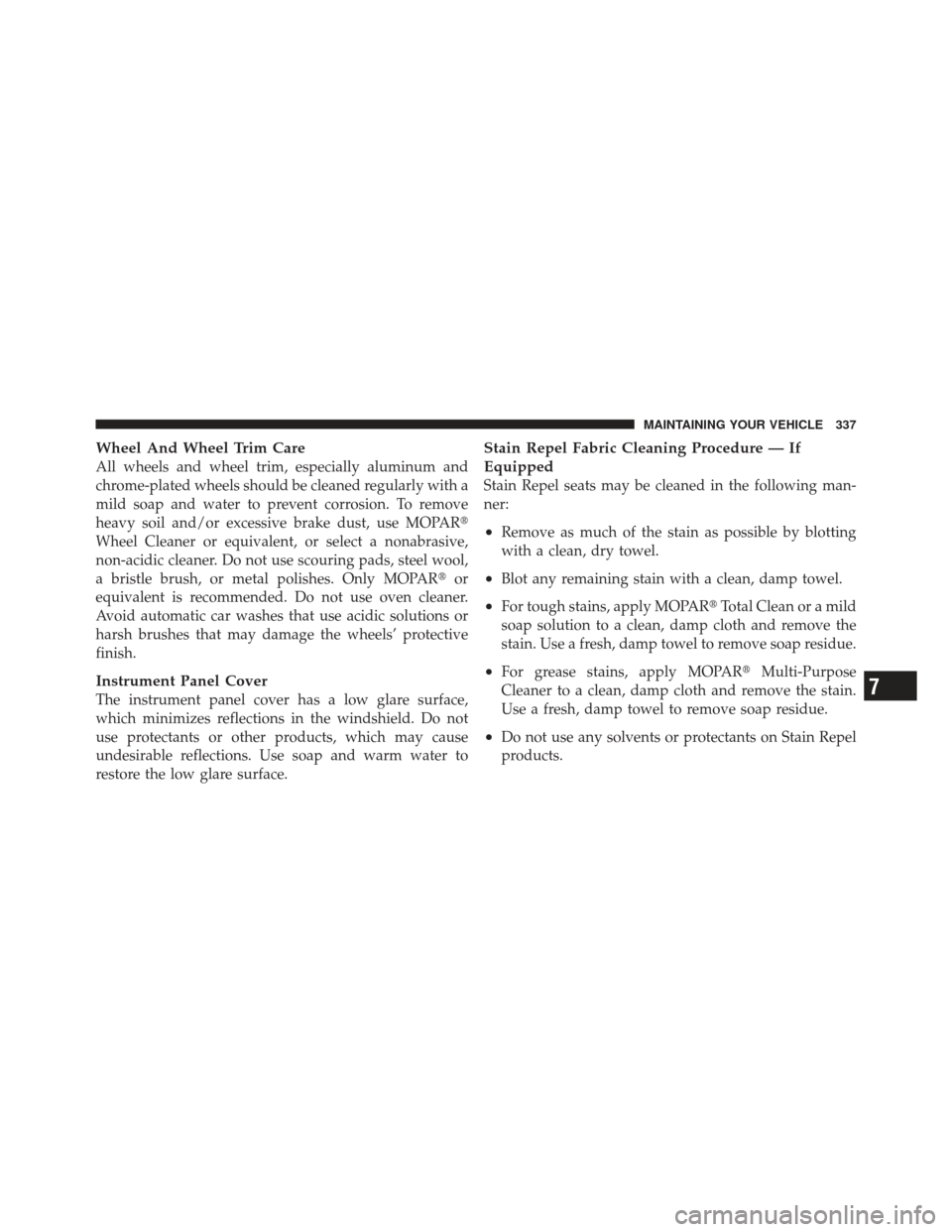Page 55 of 410

seats because this can also affect occupant classification.
Also, if you fold down the seats in the second row check
to be sure they don’t touch the front passenger seat.
If the front passenger seat is damaged in any way, it
should only be serviced by an authorized dealer. If the
seat is removed (or even if the seat attachment bolts are
loosened or tightened in any way), take the vehicle to an
authorized dealer.
If there is a fault present in the OCS, the Airbag Warning
Light (a red light located in the center of the instrument
cluster directly in front of the driver) will be turned on.
This indicates that you should take the vehicle to an
authorized dealer. The Airbag Warning Light is turned on
whenever there is fault that can affect the operation of the
airbag system. If there is a fault present in the OCS, both
the PAD Indicator Light and the Airbag Warning Light
are illuminated to show that the passenger airbag is
turned off until the fault is cleared. If an object is lodgedunder the seat and interferes with operation of the weight
sensors, a fault will occur which turns on both the PAD
Indicator Light and the Airbag Warning Light. Once the
lodged object is removed, the fault will be automatically
cleared after a short period of time.
•The
Driver and Passenger Airbag/Inflator Units are
located in the center of the steering wheel and the right
side of the instrument panel. When the ORC detects a
collision requiring the airbags, it signals the inflator
units. A large quantity of nontoxic gas is generated to
inflate the front airbags. Different airbag inflation rates
may be possible based on collision severity and occu-
pant size. The steering wheel hub trim cover and the
upper right side of the instrument panel separate and
fold out of the way as the bags inflate to their full size.
The bags fully inflate in about 50 - 70 milliseconds.
This is about half of the time it takes to blink your eyes.
The bags then quickly deflate while helping to restrain
the driver and front passenger. The driver’s front
2
THINGS TO KNOW BEFORE STARTING YOUR VEHICLE 53
Page 68 of 410

•If the belt still can’t be tightened, or if pulling and
pushing on the restraint loosens the belt, disconnect
the latch plate from the buckle, turn the latch plate
around, and insert the latch plate into the buckle
again. If you still can’t make the child restraint secure,
try a different seating position.
•Buckle the child into the seat according to the child
restraint manufacturer’s directions.
•When your child restraint is not in use, secure it in the
vehicle with the seat belt or remove it from the vehicle.
Don’t leave it loose in the vehicle. In a sudden stop or
collision, it could strike the occupants or seat backs
and cause serious personal injury.
Automatic Locking Retractor (ALR)
To operate the switchable retractor, pull the belt from the
retractor until there is enough to pass it through the child
restraint and slide the latch plate into the buckle. Then
pull on the belt until it is fully extended from theretractor. Allow the belt to return into the retractor,
pulling on the excess webbing to tighten the lap portion
around the child restraint. Follow the instructions of the
child restraint manufacture.
NOTE:
To reset this feature you must let all of the belt
webbing return into the retractor. You will not be able to
pull out more webbing until all of the webbing has been
returned back into the retractor.
Lower Anchors and Tether for CHildren (LATCH)
Your vehicle is equipped with the child restraint anchor-
age system called LATCH, which stands for Lower
Anchors and Tether for CHildren. The LATCH system
provides for the installation of the child restraint without
using the vehicle seat belt. All three rear seating positions
have lower and tether anchorages that are capable of
accommodating LATCH-compatible child seats having
flexible, webbing-mounted lower attachments. Child
seats with fixed lower attachments must be installed in
66 THINGS TO KNOW BEFORE STARTING YOUR VEHICLE
Page 122 of 410
When returning the seatback to its upright position,
make sure that the seat latches are engaged. You should
not be able to fold the seatback forward and/or tumble
the seat unless the release button is pressed, the emer-
gency release handle is pulled and/or the tumbling seat
release strap is pulled. Do not allow passengers to ride in
a rear seat if one or more of the seat latches is not
engaged.
WARNING!
Do not ride in any of the rear seating positions when
one or more of the seat latches is not engaged. Riding
with the seat latches disengaged could result in
serious or fatal injury.
NOTE: The tumbling seat tether should be clipped onto
the elastic strap provided on the base of the seat cushion
before returning the seat to its normal position.
Rear Seat Removal
The rear seats can be removed to provide more cargo
space.
1. Push and hold the button on the seatback and fold
down the rear seatback.
Folding Rear Seat Button
120 UNDERSTANDING THE FEATURES OF YOUR VEHICLE
Page 339 of 410

Wheel And Wheel Trim Care
All wheels and wheel trim, especially aluminum and
chrome-plated wheels should be cleaned regularly with a
mild soap and water to prevent corrosion. To remove
heavy soil and/or excessive brake dust, use MOPAR�
Wheel Cleaner or equivalent, or select a nonabrasive,
non-acidic cleaner. Do not use scouring pads, steel wool,
a bristle brush, or metal polishes. Only MOPAR �or
equivalent is recommended. Do not use oven cleaner.
Avoid automatic car washes that use acidic solutions or
harsh brushes that may damage the wheels’ protective
finish.
Instrument Panel Cover
The instrument panel cover has a low glare surface,
which minimizes reflections in the windshield. Do not
use protectants or other products, which may cause
undesirable reflections. Use soap and warm water to
restore the low glare surface.
Stain Repel Fabric Cleaning Procedure — If
Equipped
Stain Repel seats may be cleaned in the following man-
ner:
•Remove as much of the stain as possible by blotting
with a clean, dry towel.
•Blot any remaining stain with a clean, damp towel.
•For tough stains, apply MOPAR� Total Clean or a mild
soap solution to a clean, damp cloth and remove the
stain. Use a fresh, damp towel to remove soap residue.
•For grease stains, apply MOPAR� Multi-Purpose
Cleaner to a clean, damp cloth and remove the stain.
Use a fresh, damp towel to remove soap residue.
•Do not use any solvents or protectants on Stain Repel
products.
7
MAINTAINING YOUR VEHICLE 337